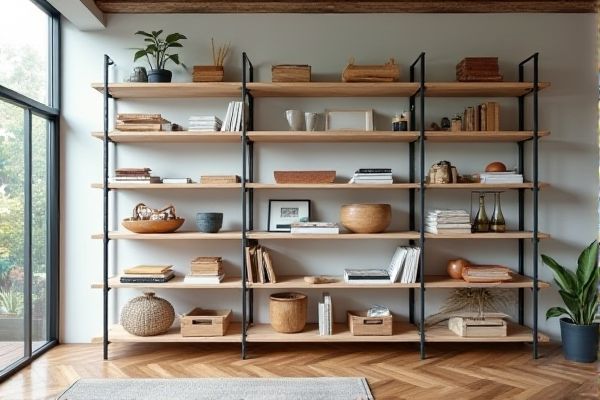
Wire shelving offers superior ventilation and moisture resistance, making it ideal for environments prone to humidity, while wood shelving provides a warm, classic aesthetic and sturdier support for heavy items. Explore the rest of the article to discover which shelving type best suits your storage needs and style preferences.
Table of Comparison
| Feature | Wire Shelving | Wood Shelving |
|---|---|---|
| Material | Metal wire, typically steel with coating | Solid wood or engineered wood |
| Durability | Highly durable, rust-resistant coatings available | Durable but susceptible to scratches and moisture damage |
| Weight Capacity | Supports heavy loads, ideal for industrial use | Varies; generally supports moderate weight |
| Ventilation | Excellent airflow, prevents dust buildup | Poor ventilation, can trap dust and moisture |
| Installation | Easy assembly, adjustable shelves | Requires tools, fixed shelf heights |
| Appearance | Industrial, modern look | Warm, classic aesthetic |
| Maintenance | Low maintenance, easy to clean | Requires regular cleaning, may need refinishing |
| Cost | Generally lower cost | Varies; higher cost depending on wood type |
Introduction to Wire Shelving and Wood Shelving
Wire shelving offers an open design that promotes air circulation and visibility, making it ideal for storage in kitchens, garages, or retail settings. Wood shelving provides a sturdy, aesthetically pleasing option with a solid surface perfect for displaying heavier or decorative items. Choosing between wire and wood shelving depends on your storage needs, space ventilation, and the desired look for your room.
Material Composition and Durability
Wire shelving consists of steel or chrome-plated metal, offering superior durability and resistance to warping, moisture, and pests compared to wood shelving, which is typically made from solid wood or engineered wood products prone to scratches and swelling. The open design of wire shelves allows for better air circulation, reducing the risk of mold or mildew, while wood shelves provide a sturdier, more aesthetic surface but require regular maintenance to prevent damage. When choosing between them, your decision should consider the environment and load type to ensure longevity and performance.
Design and Aesthetic Appeal
Wire shelving offers a minimalist, industrial design with open grids that enhance visibility and airflow, making it ideal for modern and utilitarian spaces. Wood shelving provides a warm, natural aesthetic with customizable finishes that complement traditional and contemporary interiors. Your choice depends on whether you prioritize sleek functionality or rich, decorative appeal in your space.
Installation Process and Flexibility
Wire shelving offers a straightforward installation process with adjustable brackets and minimal tools required, allowing easy customization to various wall sizes and organizational needs. Wood shelving typically demands precise measurements, wall anchors, and more complex mounting hardware, making installation more time-consuming and less adaptable after setup. Wire shelving's modular design enhances flexibility, enabling quick reconfiguration or expansion, whereas wood shelves are more permanent and less forgiving to changes.
Load Capacity and Strength
Wire shelving offers superior load capacity due to its metal construction, supporting heavier items without warping or bending. Wood shelving provides a sturdy appearance but typically has lower weight tolerance, especially under prolonged stress or moisture exposure. Your choice should consider the weight and nature of the stored items to ensure optimal strength and durability.
Maintenance and Cleaning Requirements
Wire shelving requires minimal maintenance due to its open design that prevents dust accumulation and allows easy cleaning with a simple wipe or spray. Wood shelving demands more attention, needing periodic polishing or sealing to protect against moisture, scratches, and stains. Your choice impacts cleaning effort, with wire shelving offering a more hassle-free solution for maintaining cleanliness.
Cost Comparison and Budget Considerations
Wire shelving generally offers a more cost-effective solution compared to wood shelving, with prices typically ranging from $20 to $50 per unit versus $50 to $200 or more for wood options. Wire shelves require less maintenance and are resistant to warping and moisture damage, reducing long-term replacement costs. Wood shelving may involve higher upfront investment and potential refinishing expenses but provides a sturdier aesthetic for budget-conscious projects prioritizing design.
Suitability for Different Spaces
Wire shelving offers excellent ventilation and visibility, making it ideal for kitchens, garages, and storage rooms where airflow and easy access to items are essential. Wood shelving provides a more sturdy and aesthetic option suited for living rooms, offices, and bedrooms, enhancing decor while supporting heavier objects. Your choice depends on the balance between functional needs like moisture resistance and the desired visual appeal for each specific space.
Environmental Impact and Sustainability
Wire shelving typically has a lower environmental impact due to its metal construction, which is often recyclable and made from recycled materials, reducing landfill waste. Wood shelving, while biodegradable and renewable when sourced responsibly from sustainably managed forests, can contribute to deforestation and habitat loss if not certified. Your choice between wire and wood shelving should consider these sustainability factors along with the shelving's lifecycle and potential for reuse or recycling.
Pros and Cons Summary
Wire shelving offers superior ventilation and moisture resistance, making it ideal for kitchens and storage areas prone to humidity, while its lightweight design allows easy rearrangement. Wood shelving provides a sturdy, aesthetically pleasing option with higher load-bearing capacity but can be susceptible to warping or damage in damp environments. Choosing between wire and wood shelving depends on prioritizing durability, maintenance, and environmental factors in the intended space.
 homyna.com
homyna.com